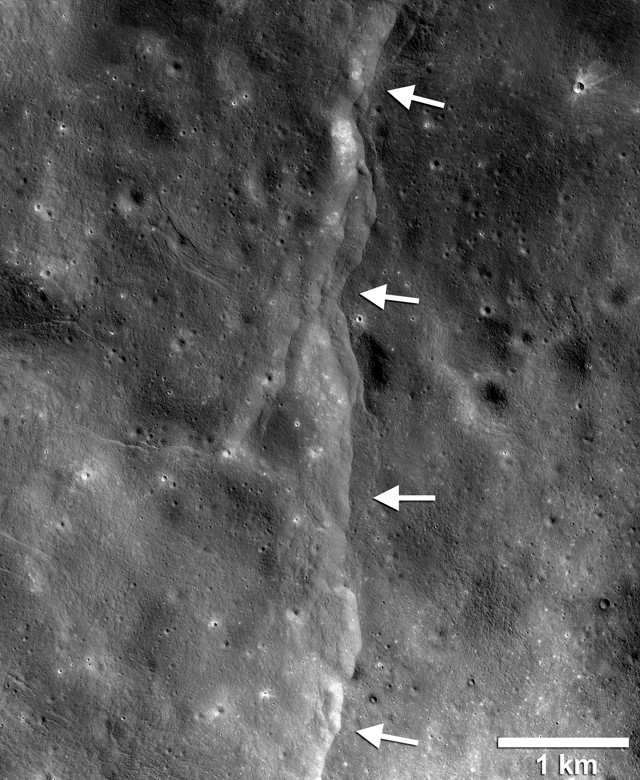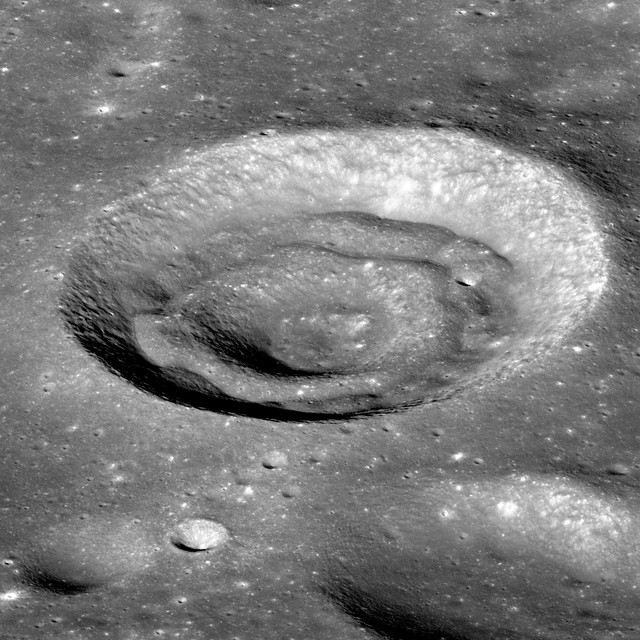
by Lucas Joel Friday, February 12, 2016

A lobate scarp on the moon. Credit: NASA/Goddard/Arizona State University/Smithsonian.
During their 1972 mission to the moon, Apollo 17 astronauts Eugene Cernan and Harrison Schmitt tried to ascend a steep rise in the lunar rover. The rover could not make it, so the pair drove up the incline in a zigzag pattern. The rise, it was later found, is the lobate scarp of a lunar thrust fault — one of many such features that, thanks to detailed images from NASA’s Lunar Reconnaissance Orbiter (LRO), are now known to occur across the moon’s surface. In a new study, researchers suggest these faults were formed by the same gravitational forces that cause the rise and fall of tides on Earth.
Using LRO images, “we’ve discovered more than 3,000 of these scarps, whereas before, fewer than 100 were known,” says Thomas Watters, a planetary geologist at the Smithsonian National Air and Space Museum and lead author of the study, published in Geology. When lunar thrust faults were first discovered, scientists thought they’d formed purely due to global contraction of the moon: As the molten early moon cooled and contracted, the faults formed, leaving the surface with a “wrinkled” appearance. But, Watters says, “we were surprised to find that global contraction wasn’t by itself able to explain the orientations of these scarps, which we found to be nonrandomly distributed across the moon’s surface.”
If global contraction alone were driving the scarps’ formation, Watters says, then they should not display any preferred orientation. But he and his team found that the scarps around the moon’s equator tend to have north-south orientations, whereas scarps located closer to the poles generally have east-west orientations. So, the researchers considered another force acting globally on the moon: tidal stresses imposed by Earth’s gravitational pull on its neighbor. When they modeled the tides’ effects on the moon in combination with global contraction, “we found that the moon’s stress field has specific, preferred orientations relative to its equator and poles,” which could explain the observed orientations of the scarps, Watters says.
Such structures don’t tend to survive long due to reshaping of the moon’s surface by meteorite bombardment, so the present scarps are likely young features geologically speaking, “probably younger than 50 million years,” Watters says. And they’re also small — usually less than 10 kilometers long and only tens of meters high — compared to thrust-fault scarps on Earth. The scarps’ short lengths could be caused by the relatively weak stresses produced by tidal forces. “These stresses can only cause faults to move if [the faults] are at relatively shallow depths, or low pressures; and shallow faults will typically produce small-scale surface features” like the observed scarps, says Francis Nimmo, a planetary geophysicist at the University of California at Santa Cruz who was not involved in the study. “It probably also helps that near-surface lunar rock is more fractured [than deeper rock] and, thus, is easier to move,” Nimmo says.

Oblique view of an unnamed crater located in Apollo Basin on the moon. The concentric crater has a diameter of 11.5 kilometers. Credit: NASA/Goddard/Arizona State University.
Rock at the lunar surface is not only fractured by faults, but also by large meteorite impacts that have left the moon covered in craters. In a separate study in Geophysical Research Letters, the extent of fracturing — referred to as porosity — has been found to increase in relation to the size of a crater. Studying changes in porosity provides a window into the nature of the moon’s crust, as well as into the crustal evolution of other solid planetary bodies like Earth.
To investigate the moon’s near-surface porosity, a team led by Jason Soderblom of MIT used data from NASA’s lunar-orbiting GRAIL spacecraft to analyze anomalies in the moon’s gravitational field called Bouguer anomalies (BA). “We found that, for craters up to about 100 kilometers in diameter, BA values become increasingly negative, which means porosity levels are [greater] due to events like impact fracturing,” Soderblom says. For craters larger than 100 kilometers across, though, “there’s no continued increase in total porosity, which we interpret to be evidence that there’s some maximum depth to which porosity can persist on the moon, due perhaps to overburden pressure from the crust.”
Oddly, some craters display positive BA values, meaning they are less porous than surrounding rock. Soderblom says this seemed counterintuitive at first, but that, if an impactor struck rock that already had high porosity, then “you could melt out the rock, crush out pore space, and that ends up reducing the porosity.”
The moon, because it does not have active plate tectonics or the same high rates of erosion that Earth does, preserves a relatively complete record of impact cratering. The data in the new study are “going to help us understand how many impacts [there have been] on the moon’s crust since the time it solidified,” says David Minton of Purdue University, who was not involved in the work. This should also give us an idea of what the porosity of Earth’s crust through time may have been like, Minton says.
Understanding the evolution of rock porosity on Earth is critical, Soderblom says, because porosity increases the surface area of rocks, which increases chemical weathering rates. And chemical weathering of rock likely provided essential nutrients for early life on the planet.
© 2008-2021. All rights reserved. Any copying, redistribution or retransmission of any of the contents of this service without the expressed written permission of the American Geosciences Institute is expressly prohibited. Click here for all copyright requests.